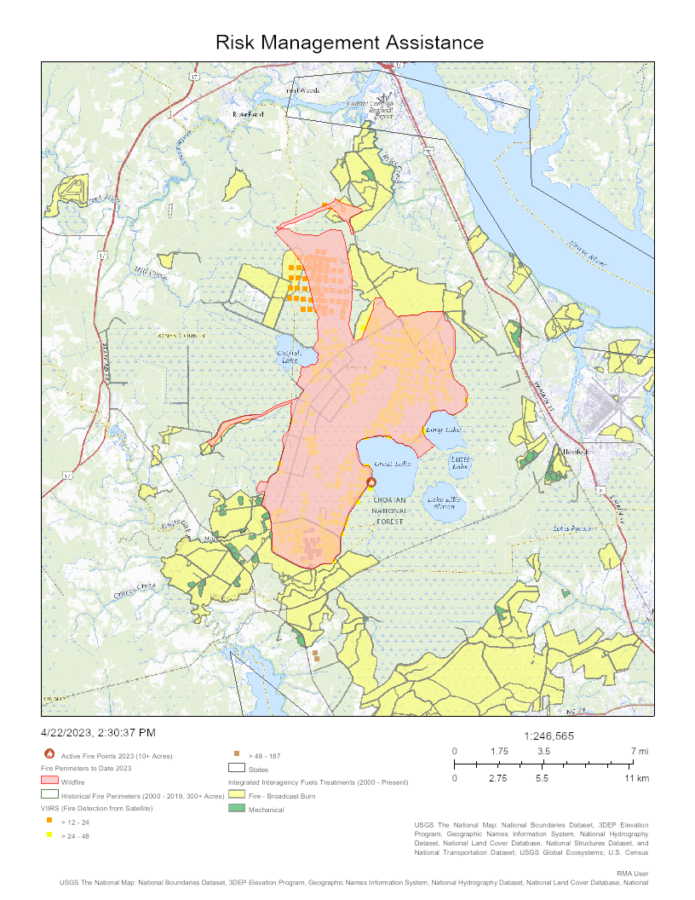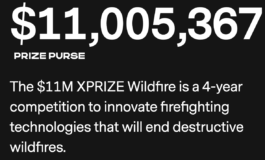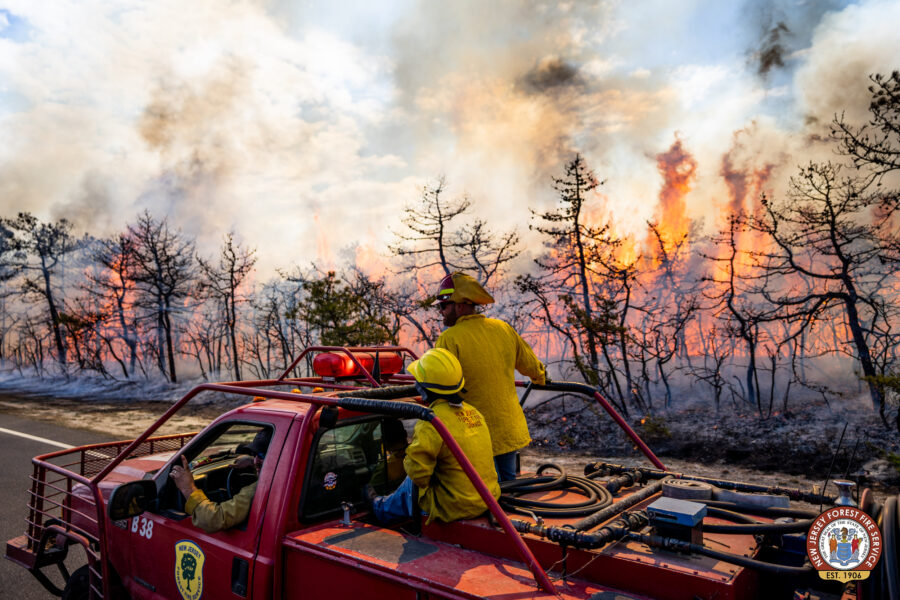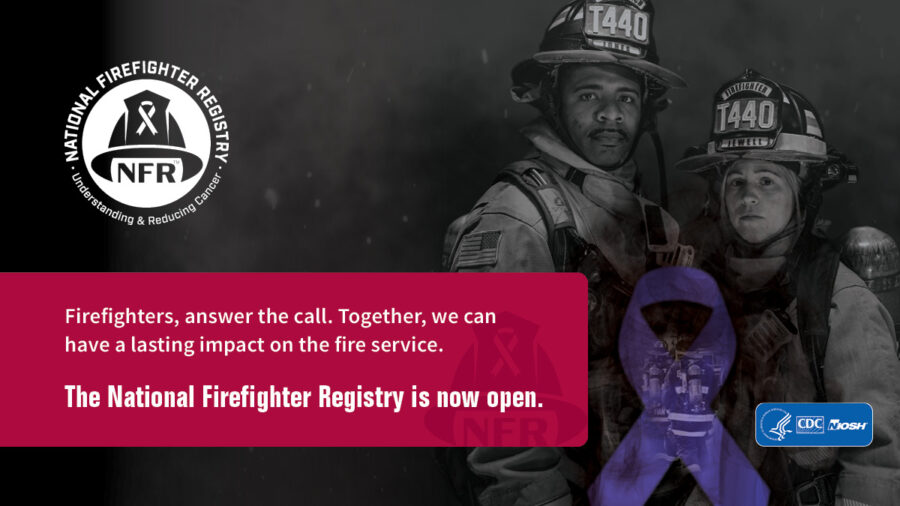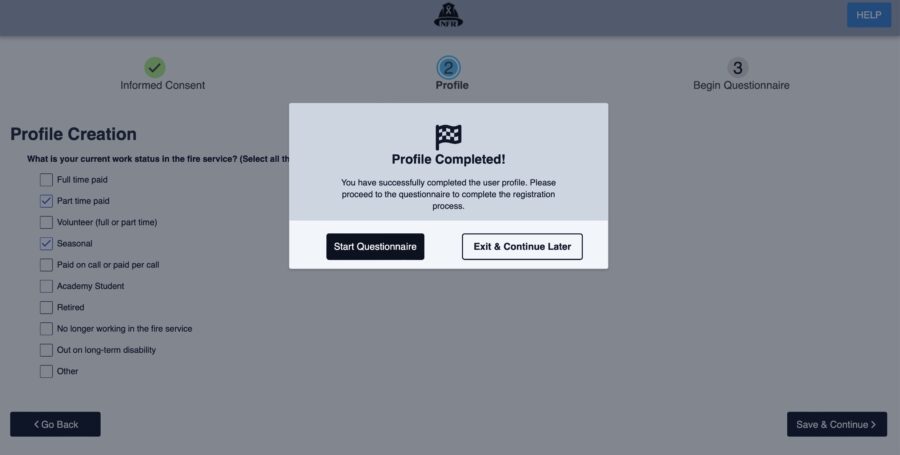On April 22, 2023, Earth Day 2023, the largest fire of national note is burning in North Carolina.
For April 21, the most recent update of the national portal for the Geographic Area Coordination Centers – because it’s not quite busy enough for weekend staffing – there are three GACCs at Preparedness Level 2 – Eastern, Southern, and Southwest – while the rest of the country is at PL 1. And a scan of national-level fire hazards doesn’t show any Red Flag Warnings or Watches for the day.
For the prior week, national initial attack activity in the National Situation Report was considered light at 1,075 fires, with 50 large fires reported and 50 contained. Fire names ranged from a label only an agency can love (AR-BUP-000924 in the Buffalo National River) to a menagerie of animals – Swine, Third Goat, Antelope Flats, Wolf Creek, Otter Creek, Kingfisher Hollow – to the uniquely local – Natural Bridge (named for the actual Natural Bridge in Kentucky), Muzzle Loader Club (perhaps the local shooting range in Oklahoma?), Jimmys Water Hole in New Jersey and Shinhollow in New York, and Tinaja in southern Arizona (translated from the Spanish as “large earthenware jar”).
The Fire Weather Outlook for Earth Day was minimal except for southwest Arizona. The Day 2 Fire Weather Outlook for today noted that “Elevated conditions are likely near the international border in the Lower Colorado River Basin, as 15 mph sustained southwesterly surface winds overlap with 15 percent humidity for a few hours around afternoon peak heating. Elevated highlights were added since fuels should be marginally receptive to fire spread.” Looking ahead, the only fire hazard of note in the fire weather outlook is for the New Mexico-Texas-Mexico area on Tuesday-Wednesday, April 25-26.
All this being duly noted, one can be certain that residents near the Great Lakes Fire will agree that this fire (also called the Great Lake Fire) likely holds claim to being Earth Day’s fire of note in the U.S. Named for a singular Great Lake, with other lakes around it, in the Croatan National Forest), the fire quadrupled in size in 24 hours, from 7000 to an estimated 30,000+ acres, with a national Southern Area fire management team being assigned.
As noted yesterday in our partner site, FireAviation.com, the VIIRS satellite data offered space-based mapping of yesterday’s growth that was confirmed in the map available today from the Risk Management Assistance Dashboard … compared to yesterday’s rapid spread, the majority of recent heat signatures are to the north, where the fire is burning into and between past fuel treatments. The fire has definitely outgrown the 21,000 acre footprint of 2012’s Dad Fire.
Additional mapping is being shared by Joseph Elfelt …
#GreatLakeFire Croatan National Forest North Carolina. Symbols on the map are heat detection by MODIS and VIIRS satellites. Not real time, locations approximate. To learn more click “Map tips” upper left corner. #NCwx
Open #GISsurfer map: https://t.co/umbMEa89VB pic.twitter.com/CoZJIpBVD1
— Joseph Elfelt post.news/mappingsupport (@MappingSupport) April 21, 2023
And current info arrives from a variety of Twitter posts with the handle of #GreatLakeFire (no plural) …
Great Lakes Fire estimated at 35,000 acres, 10% containment. Southerly winds expected to continue through Sat. evening. Communities north of Croatan National Forest can expect smoke impacts to continue. More: https://t.co/K7lWSwbMko pic.twitter.com/8Gvg5Kq0XJ
— N.C. Forest Service (@ncforestservice) April 22, 2023
#SATELLITE SPOTLIGHT: @NOAA‘s GOES16🛰️ is tracking the smoke from a #wildfire in Croatan National Forest in North Carolina today. Officials estimate the blaze has already burned more than 35,000 acres since Wednesday. #NCwx pic.twitter.com/JpVFkKwjJA
— NOAA Satellites – Public Affairs (@NOAASatellitePA) April 21, 2023
A recent tweet equated the fire’s size to the acreage of DisneyWorld, which, in case you were curious, was forecast to have average crowds for Earth Day according to the Magic Guides Crowd Calendar.
There is no current estimate for how many firefighters are working the Great Lake(s) Fire, though it’s certainly increasing. Yesterday’s census for the Southern Area had some 1200 resources assigned in the overall GACC area.

